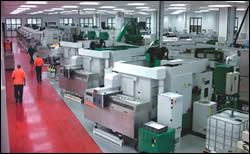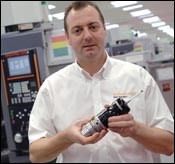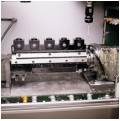RAMTIC System Still Ticking
When it first appeared in the early 1990s, RAMTIC (Renishaw’s Automated Milling, Turning and Inspection Center) pioneered the use of portable carrousels for palletized workpieces and the use of artifacts, or master components, by which a machine tool could check its own dimensional calibration. This innovative approach to process control is still highly effective as applied in the company’s most advanced machine shop, which opened in 2006. Carrousels and artifacts are very much a part of this new shop’s remarkable success.
Share


This article is going to discuss artifacts, pyramids and a place called Stonehouse. It will even use the word “relic.” But this isn’t about archeology or ancient history. Instead, it is about advanced manufacturing in the 21st Century and one company’s strategic vision for rapidly developing new products while maintaining competitive manufacturing in its home country.
Renishaw, a U.K.-based maker of metrology systems, developed RAMTIC, its unique approach to process control, in the early 1990s. When it first appeared, RAMTIC (Renishaw’s Automated Milling, Turning and Inspection Center) was characterized by two conspicuous developments in tangible machine tool technology. One was the use of portable carrousels for palletized workpieces and cutting tools. The other was the use of artifacts, or master components, by which a machine tool could check its own dimensional calibration.
RAMTIC was also based on some critical intangibles—most notably a focus on design for manufacturability and an effort to prove out processes thoroughly before releasing them to the shop floor. As introduced, the RAMTIC concept enabled the company to use standard, relatively low-cost VMCs to achieve a degree of machining accuracy and a level of automation that were virtually unprecedented at the time.
Fast-forward to mid 2006, when the company opened a new machining facility within a completely refurbished factory building. All of its precision small-parts machining operations were consolidated at this location, referred to as Stonehouse after the name of the village nearby. The intent was to create one of the most advanced machine shops in the world. Much was at stake in this move.
Renishaw needed to expand its manufacturing capability to keep up with a faster pace of product introduction. The company wanted to keep its commitment to do most of its manufacturing in the U.K. That meant that in-house production had to be as efficient and as economical as anywhere in the world.
After the plant opening, several questions arose. Was the 15-year-old RAMTIC system still viable, and would it find a home in the new facility? Is the shop there still using the carrousels and artifacts? How has Renishaw’s manufacturing philosophy evolved, as manifested in the new facility?
To answer: Yes, RAMTIC technology is going strong there, proving the lasting validity of the original concepts. RAMTIC continues to deliver highly automated production with reliable process control. The pallet-pool carrousels and the artifacts, with some tweaking and refinements, are in daily use. More importantly, the principles of design for manufacturability and thorough process prove-out are being applied in a more extensive and rigorous way. In fact, they are two of the major underpinnings of the current system of production control that governs the entire factory.
Renishaw calls this fundamental methodology the Renishaw Productivity System. Whereas RAMTIC can be seen as an example of process control applied at the machine level, the larger Renishaw Productivity System can be seen as the essential foundation that makes process control possible and effective on a factory-wide basis.
Stonehouse demonstrates that with an intelligent strategy and a strong commitment, any manufacturer should be able to keep production on its own turf.
RAMTIC At A Glance
A major impetus for developing RAMTIC was the lack of climate control in Renishaw’s original 1980s machine shop. Wide swings in ambient temperature combined with heat generated inside the machines contributed to unstable machining conditions.
At the same time, demand for the company’s probing instruments was growing rapidly. The need to increase production and automate processes was apparent. Renishaw’s engineering staff resolved to develop a comprehensive methodology to address the problems and challenges created by this situation. From the start, this effort was NOT conceived as merely a fix for temperature-induced variations in processes and related barriers to automation. Rather, the company sought a strategy that would set its manufacturing operations on the right course for years to come.
Process innovations had to be tied to and spring from design and engineering considerations. For example, engineers began to put together a “Design For Manufacture Guidebook” that established and communicated best practices. This guidebook codified a standardized library of part features linked to proven machining processes of known statistical capability. Effective and efficient manufacturing could be virtually locked in during the design phase.
In the meantime, means of streamlining and automating machining processes got underway. Engineers looked for ways to solve several problems or generate multiple benefits at once. For example, the portable pallet carrousels were developed as more than just a means of loading and unloading workpieces at the VMCs automatically. Uniform dovetail fixtures provide not only multi-part setups for multi-sided machining, but also racking for sets of cutting tools. Thus, the carrousel delivers all of the required tools and all of the parts at the same time.
What’s more, the carrousels cleverly serve as a workflow regulating system that balances work in progress with inventory stocking requirements. The multi-part fixtures are purposefully loaded with an array of part sets that represent numerous “kits.” Each kit includes all of the main components for assembly into a complete product. The assortment of kits is based on signals from the company’s MRP system. Thus, a carrousel becomes a “batch of batches,” with the economic order quantity always synced to demand. Once a carrousel is docked at a machine, operator involvement ceases until every part is finished about 25 hours later.
Perhaps the most inventive development derived from the RAMTIC engineering effort is the artifact-comparison technique. Artifacts are master components that represent either a generic set of machined features such as slots, bores and bosses or a replica of a specific work piece. In either case, the artifact has the same thermal expansion properties of the material to be machined. The artifact is calibrated on a CMM before being stored on a machine. (Mounted on the same dovetail fixture used for parts and tooling, artifacts can be delivered and exchanged by carrousel).
The artifact enables the machine tool to compensate for thermal growth in the workpiece and/or machine structure. In addition, it allows on-machine measurement to be linked to a traceable measurement standard. As a result of these two benefits, it makes automated on-machine verification possible, thereby eliminating costly, time-consuming manual inspection after machining. Periodically, the artifact is probed on the machine and the results are compared with calibrated dimensions. Any deviation can be used to compensate for the apparent error automatically. According to the company, with a generic artifact, a process can be held to tolerances of 50 microns. Tolerances of 20 microns can be held with a workpiece-specific artifact.
By 1993, RAMTIC technology was fully implemented on four machines. It was delivering all of the planned-for results, including long stretches of unattended operation, dimensional tolerances held to the micron level and cycle times 50 to 75 percent lower than previous norms.
In 1995, Renishaw moved its machining operations to a new, climate-controlled facility within its New Mills headquarters in Wotton-under-Edge in Gloucestershire. This new space opened with seven RAMTIC cells in place. For the next ten years, the New Mills facility was continuously upgraded and enlarged, eventually winding up with 19 RAMTIC cells in production.
However, by 2004, the New Mills facility had no room for more machines. Yet the company intended to diversify further into new areas of industrial metrology. That entailed a larger overall number of parts to produce and a greater variety of part types. Additionally, the company would need to get finished products to market in less time. It was clear to top management that a new factory would soon be needed. After considering the options, the company elected to buy a large existing factory building and rebuild its interior as a clean, well-lit, well-ventilated manufacturing space. The building, which formerly housed an injection molding plant, is located a few miles from company headquarters.
A Snapshot Of Stonehouse
Besides being clean and bright, the renovated Stonehouse is roomy. Opened in April 2006, it covers 100,000 square feet—70,000 devoted to the machine shop and 10,000 devoted to parts finishing and anodizing. About 5,000 different parts are produced here in quantities totaling about 400,000 a month.
Significantly, RAMTIC still forms the backbone of the company’s machining operations at Stonehouse. RAMTIC is used on a line of 28 Mazak AJV and FJV machines. These have been modified to include a transfer mechanism for shuttling the dovetail pallet fixtures and an indexer featuring a triangular base held horizontally between centers (for three-sided machining of the pallets). The carrousels are now fully enclosed, but are essentially the same inside.
Likewise, artifacts still play a critical role, but compensating for thermal distortion in no longer the primary function. The ambient temperature inside Stonehouse is controlled to ±3.5o F, as is the temperature of the coolant at each machine. The machines have built-in features to control the effect of heat on spindles and ballscrews. Heat does have an effect on machine behavior, but it is relatively slight. Probing routines track and eliminate its effects by re-establishing the location of key datum points and updating a work coordinate. This check is performed before machining each new pallet.
Nevertheless, the artifact provides an essential link to a known standard of accuracy derived away from the machine. This traceability makes on-machine verification possible. The artifact also helps reduce measurement uncertainty. Periodically, the artifact is probed on the machine to compare its size with the CMM-calibrated dimension. Any error detected can be used to derive a scaling factor to correct other measurements made on the machine.
Stonehouse, stripped to a shell, presented engineers with a clean slate for laying out an ideal machining facility. This opportunity accounts for many distinctive differences between the old site and the new.
Here is a quick run-down of the most prominent features:
- Machine group hubs. These localized supply centers provide all of the tooling, setup and inspection equipment needed for the machines nearby.
- Centralized chip conveyor. Aluminum chips, produced in substantial volumes during high speed machining, are collected at a compactor. The dried and briquetted chips get a premium from the scrap recycler.
- An upgraded raw materials prep area. CNC cut-off saws and an automated deburring station get blank parts to the kitting area without delay. The deburred blanks can be located and seated on the fixtures more consistently.
- Integrated engineering and shop floor staff. Manufacturing engineers are stationed adjacent to the shop floor for regular interaction with operators.
- Aqueous part cleaning stations. Parts are cleaned promptly in compliance with strict solvent emission standards.
Pyramid Of Power
A visitor to the shop floor at Stonehouse could be easily dazzled by its open, tidy appearance and wowed by a closer look at its machining efficiencies. However, what is visible is only part of the story. Perhaps more impressive (and equally important) are the unseen engineering principles that, layer by layer, build up a foundation for the process control in place at the machines. These are graphically summarized in the pyramid on page 86.
A few comments about design for manufacturing (DFM) and maintaining a stable shop environment will suffice to sketch out this larger picture. DFM has truly come into its own since Stonehouse opened. The old machine shop at New Mills is now devoted to proving out part production and to developing new machining processes. Each machine at New Mills duplicates one in each class of machines at Stonehouse—identical machines in identical conditions. Here, the manufacturing engineer can develop, verify and document every aspect of a new part process, from cost analysis, fixture design and CNC programming to tooling selection, trial runs and capability studies. Likewise, processes that are not covered in the DFM guidelines (now disseminated electronically across the company’s intranet) are tested here before being added to the library.
By the time a new part is released for production, all of the manufacturing problems have been addressed. As Gareth Hankins, GM of Renishaw’s Manufacturing Services Division, points out, DFM is the best opportunity for achieving production economies because most of the decisions that affect part cost are made during the design phase.
Thus, it’s not surprising that most of Renishaw’s manufacturing engineers are now focused on DFM. Only a third is involved in the support of operations currently running in production. It used to be the other way around. A similar shift in focus has occurred in the duties of shop floor personnel.
Their main responsibilities now lie in the middle section of the productivity pyramid. Most shopfloor activities revolve around maintaining a stable operating environment rather than tending the machining processes. These highly automated systems essentially run themselves, but they cannot achieve consistently predictable results unless sources of variation are constantly kept under control.Establishing standard, best practices and following them rigorously is the key. An example is the “pre-flight checklist” that machine operators must tick off, sign and have a supervisor review. The list ensures that appropriate checks and day-to-day maintenance tasks are completed before a day’s production can begin.
The Artifact To Become A Relic?
In addition to the 28 RAMTIC cells at Stonehouse, the shop is home to 20 Citizen sliding headstock (Swiss-type) lathes and six Mori Seiki turn-mill centers. The lathes provide turning capacity for parts less than 32 mm in diameter. The turn-mill centers handle workpieces too large for the RAMTIC cells.
Working with these machines has given engineers insight into new process control techniques. For example, a system of “in-cycle gaging” has been implemented on the mill-turn machines. Probing routines for the Swiss-type lathes are also being developed.
Mr. Hankins believes that turn-mill and other types of multi-tasking machines may represent the next generation of machining platforms that will ultimately supplant the RAMTIC cells. Exactly what the machining systems at Stonehouse will evolve to is open. That they will evolve is certain. The use of both bar feeders and gantry loaders on the turn-mill machines has engineers rethinking the role of the parts carrousels. However, what is clear to Paul Maxted, one of the shop’s principle engineers, is that reliance on artifacts will remain to provide a high level of in-house traceability.
In any case, the Renishaw Productivity System serves as a proven framework for evaluating new options for part processing and further integration of machine tool probing. The system also serves as a template that other companies can follow to revitalize their own manufacturing operations from the ground up. Stonehouse is the living showcase of the system’s effectiveness—not a shadow from the past, but a beacon into the future.
Related Content
Shop Reclaims 10,000 Square Feet with Inventory Management System
Intech Athens’ inventory management system, which includes vertical lift modules from Kardex Remstar and tool management software from ZOLLER, has saved the company time, space and money.
Read MoreCutting Part Programming Times Through AI
CAM Assist cuts repetition from part programming — early users say it cuts tribal knowledge and could be a useful tool for training new programmers.
Read More4 Commonly Misapplied CNC Features
Misapplication of these important CNC features will result in wasted time, wasted or duplicated effort and/or wasted material.
Read MoreSetting Up the Building Blocks for a Digital Factory
Woodward Inc. spent over a year developing an API to connect machines to its digital factory. Caron Engineering’s MiConnect has cut most of this process while also granting the shop greater access to machine information.
Read MoreRead Next
Under Control
This small-parts machining operation combines superbly automated workholding and handling with total machining process management.
Read MoreOEM Tour Video: Lean Manufacturing for Measurement and Metrology
How can a facility that requires manual work for some long-standing parts be made more efficient? Join us as we look inside The L. S. Starrett Company’s headquarters in Athol, Massachusetts, and see how this long-established OEM is updating its processes.
Read More






























